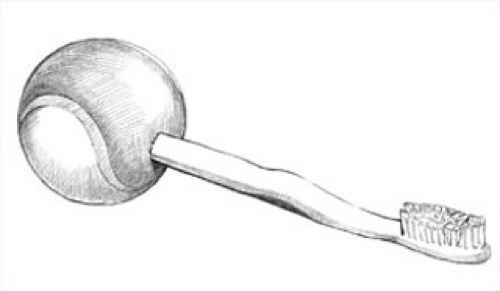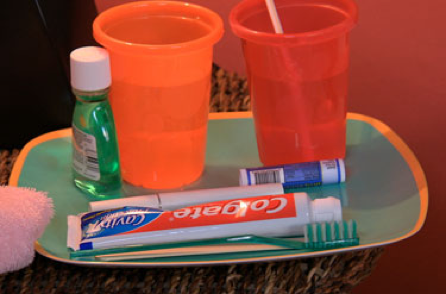Signs and Symptoms of Oral Cancer:
- Before and after mouth care, ask the person to open their mouth and stick out their tongue. Look into the mouth, using a flashlight. If you see crusts on the tongue or lining of the mouth and debris around the teeth, give mouth care more often.
- A sore of the mouth that bleeds easily or does not heal
- A red or white patch anywhere in the mouth
- A lump, thickening, rough spot, crust or small eroded area
- Pain, tenderness, or numbness anywhere in the mouth or on the lips
- Difficulty chewing, swallowing, speaking or moving the jaw or tongue
- A change in the way the teeth fit together
If you notice any of these changes, contact the person’s dentist or doctor immediately.
If the Person has Crusts or Reddened Gums
- Brush teeth twice a day with an ADA-accepted fluoride toothpaste and a soft-bristled brush.
- To brush the teeth correctly:
- Before and after mouth care, ask the person to open their mouth and stick out their tongue. Look into the mouth, using a flashlight. If you see crusts on the tongue or lining of the mouth and debris around the teeth, give mouth care more often.
- If the person’s gums or lining of the mouth are reddened, tender and bleed easily, give mouth care more often and think about a visit to the dentist, if the signs persist. When a person takes medicines that thin the blood (such as Coumadin or Heparin), the person’s gums may bleed more easily.
If the Person has a Dry Mouth
- Offer water to sip regularly
- Try over-the-counter saliva substitutes
- Urge the person to breathe through their nose, not their mouth
- Add moisture to the air at night with a room humidifier
- Sugar-free candy or gum stimulates flow of saliva
- Artificial saliva and oral rinses (available in drug stores) can be soothing
If the Person has Stomatitis
- Tell them to avoid drinking alcohol
- Do not use commercial mouthwash
- Have the person stop smoking
- Brush the teeth frequently throughout the day, using a soft bristled toothbrush
- Talk to the person’s doctor about using any mouth rinses and prescribing a mild pain medicine or a local anesthetic rinse
If a Person is on Chemotherapy
Cancer patients who receive chemotherapy often have dry mouths and swelling and tenderness of the gums. Use a toothbrush with soft bristles due to increased tenderness and chance of bleeding.
To offer relief:
- Rinse the mouth every three hours during the day
- Rinse with a mixture of:
- 1 cup warm (not hot) water
- ¼ teaspoon baking soda
- 1/8 teaspoon salt
- Take sips and swish around in the mouth
- Keep the lips moist with a lip balm like ChapStick®
- Suck ice chips, other frozen liquids, or solutions recommended by their doctor
If a Person Can’t Handle a Toothbrush
When a person loses the ability to hold a toothbrush easily:
- Provide a brush with an enlarged handle
- Electric toothbrushes have larger handles
- Another option is to take a soft rubber ball, make a hole in the center, and push the toothbrush handle through the ball. The ball is easy to grasp and allows the person to brush their teeth on their own.
If a Person Begins to Choke
Certain people have a greater risk for choking because they cannot swallow normally. Water and toothpaste build up in the mouth quickly.
Persons most at risk for choking include those with:
- Stroke
- Cerebral palsy
- Guillain-Barre’ syndrome
- Multiple sclerosis (MS)
- Amyotrophic Lateral Sclerosis (Lou Gehrig’s disease)
- Loss of sensation from diabetes
- Parkinson’s disease
- Myasthenia gravis
- Muscular dystrophy
- Obstructions in the throat (such as head and neck cancer, esophageal webs)
- Vagotomy
Signs of Difficulty Swallowing
Persons who have difficulty swallowing are at risk for choking. Watch the person you care for eat a meal.
- Does their voice change?
- Do they only eat part of each meal?
- Do they drool liquids and chewed food or cough during or after a swallow?
- Do they pocket food and saliva in the side of mouth?
- Do they take a long time to eat?
What to Do if Choking Occurs
- If the person begins to choke while you give mouth care, stop brushing or rinsing
- Have the person spit out secretions and sit up straight. If the person is lying down, have the person stay on their side with their face turned down toward the mattress.
- If you have a gravy baster, use it to remove excess saliva or toothpaste. Squeeze the bulb, insert the tip of the baster into the back of the mouth, release the bulb to remove secretions, then remove the baster from the mouth. Do Not Squeeze the bulb when secretions are in the baster.
- If choking continues, and the person cannot talk or has trouble breathing call 911
- While waiting for emergency services, perform the Heimlich Maneuver
- See our lesson on Feeding a Person for steps to follow in performing a Heimlich Maneuver.
Brushing Teeth of Bedridden Person
- Soft bristled toothbrush. An even rounded brush with soft multi-tufted nylon bristles is best. If the person does not respond well and you have trouble reaching the teeth, use mouth swabs you can purchase at the medical supply store.
- Fluoride toothpaste
- Essential oil-containing mouthwash
- Two glasses of water and a straw
- A small face towel
- Paper towels
- A bathroom sink or if in bed, use a shallow bowl or small plastic emesis (eM- ah- sis) basin (you can buy at a medical supply store)
- Disposable gloves (you can buy at a medical supply store)
- A gravy baster (if the person has trouble spitting or swallowing)



